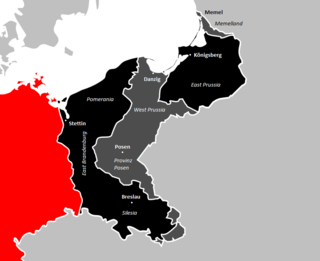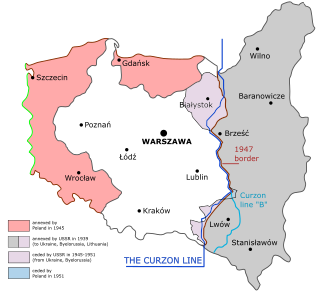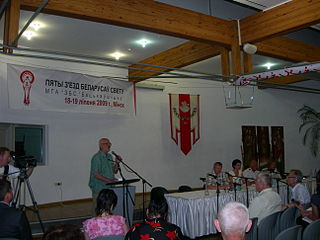
East Prussia was a province of the Kingdom of Prussia from 1773 to 1829 and again from 1878 ; following World War I it formed part of the Weimar Republic's Free State of Prussia, until 1945. Its capital city was Königsberg. East Prussia was the main part of the region of Prussia along the southeastern Baltic Coast.

The Generalplan Ost, abbreviated GPO, was the Nazi German government's plan for the genocide and ethnic cleansing on a vast scale, and colonization of Central and Eastern Europe by Germans. It was to be undertaken in territories occupied by Germany during World War II. The plan was attempted during the war, resulting indirectly and directly in the deaths of millions by shootings, starvation, disease, extermination through labor, and genocide. However, its full implementation was not considered practicable during major military operations, and never materialized due to Germany's defeat.

The German Expellees or Heimatvertriebene are 12-16 million German citizens and ethnic Germans who fled or were expelled after World War II from parts of Germany annexed by Poland and the Soviet Union and from other countries, who found refuge in both West and East Germany, and Austria.

Volhynia, is a historic region in Central and Eastern Europe, between south-eastern Poland, south-western Belarus, and western Ukraine. The borders of the region are not clearly defined, but the territory that still carries the name is Volyn Oblast, in western Ukraine. Volhynia has changed hands numerous times throughout history and been divided among competing powers. For centuries it was part of the Polish-Lithuanian Commonwealth. After Russian annexation all of Volhynia was part of the Pale of Settlement designated by Imperial Russia on its southwesternmost border.

The former eastern territories of Germany refer in present-day Germany to those territories east of the current eastern border of Germany which historically had been considered German and which were lost by Germany after World War II. Territories acquired by Poland after World War II were officially called there the Recovered Territories. These territories had been ruled as part of Poland by the Piast dynasty in the High Middle Ages with the exception of East Prussia which originally was inhabited by Old Prussians and came under Polish suzerainty in the Late Middle Ages. The northern half of historic East Prussia was, however, made part of the Soviet Union, with the former Klaipeda Region reattached to the Lithuanian Soviet Socialist Republic, and the rest being annexed by the Russian Soviet Federative Socialist Republic as the Kaliningrad Oblast, now forming a Russian exclave.

Eastern Borderlands or simply Borderlands was a term coined for the eastern part of the Second Polish Republic during the interwar period (1918–1939). Largely agricultural and extensively multi-ethnic, it amounted to nearly half of the territory of pre-war Poland. Historically situated in the eastern Polish–Lithuanian Commonwealth, following the 18th-century foreign partitions it was annexed by Russia and partly by the Habsburg monarchy (Galicia), and ceded to Poland in 1921 after the Peace of Riga. As a result of the post-World War II border changes, none of the lands remain in Poland today.

The Sudetendeutsche Landsmannschaft is an organization representing Sudeten German expellees and refugees from the Sudetenland in Czechoslovakia. Most of them were forcibly expelled and deported to western Allied occupation zones of Germany, which would later form West Germany, from their homelands inside Czechoslovakia during the expulsion of Germans after World War II.

A partisan is a member of an irregular military force formed to oppose control of an area by a foreign power or by an army of occupation by some kind of insurgent activity. The term can apply to the field element of resistance movements. The most common use in present parlance in several languages refers to occupation resistance fighters during World War II, especially under Yugoslav partisan leader Josip Broz Tito.
German Hungarians are the German-speaking minority of Hungary, sometimes called Danube Swabians, many of whom call themselves "Shwoveh". There are 131,951 German speakers in Hungary. Danube Swabian is a collective term for a number of German ethnic groups who lived in the former Kingdom of Hungary, including the Kingdom of Croatia-Slavonia and Vojvodina.

During World War II, Lithuania was occupied by the Soviet Union (1940–1941), Nazi Germany (1941–1944), and the Soviet Union again in 1944. Resistance during this period took many forms. Significant parts of the resistance were formed by Polish and Soviet forces, some of which fought with Lithuanian collaborators. This article presents a summary of the organizations, persons and actions involved.

The Polish population transfers in 1944–46 from the eastern half of prewar Poland, were the forced migrations of Poles toward the end and in the aftermath of World War II. These were the result of Soviet policy that was ratified by the Allies. Similarly, the Soviet Union had enforced policies between 1939 and 1941 which targeted and expelled ethnic Poles residing in the Soviet zone of occupation following the Nazi-Soviet invasion of Poland. The second wave of expulsions resulted from the retaking of Poland by the Red Army during the Soviet counter-offensive. It took over territory for its republic of Ukraine, a shift that was ratified at the end of World War II by the Soviet Union's then Allies of the West.

The Belarusian diaspora refers to emigrants from the territory of Belarus as well as to their descendants.

Deportations from East Prussia during World War I was a forced deportation of local inhabitants from Russian-occupied areas of East Prussia to remote areas of the Russian Empire in 1914–1915. The official rationale was to reduce espionage and other resistance behind the Russian front lines. As many as 13,600 people, including children and the elderly, were deported to Siberia. Due to difficult living conditions, the mortality rates were high and only 8,300 people returned home after the war. However, the deportations have received very little attention from scholars as they were overshadowed by the much larger refugee crisis in Russian Empire and the expulsion of Germans after World War II.
The Landsmannschaft der Deutschen aus Russland is an organization of German refugees expelled from their homes in Russia to West Germany after World War II.
The Landsmannschaft der Banater Schwaben e.V. is an organization of German Banat Swabians refugees expelled from their homes in Banat, Romania after World War II.
The Bund der Danziger is an organization of German refugees from Danzig expelled from their homes after World War II. The organization was founded in 1946.
The Landsmannschaft der Bessarabiendeutschen is an organization of Bessarabia German refugees expelled from their homes after World War II.
The Landsmannschaft der Buchenlanddeutschen is an organization of German refugees expelled from their homes in Bukovina and Bessarabia after World War II.
The Karpatendeutsche Landsmannschaft Slowakei is an organization of German refugees expelled from their homes in Slovakia after World War II. The organization is based in Stuttgart, and it was founded in 1949.
The Pommersche Landsmannschaft is an organization of German refugees expelled from their homes in Pomerania after World War II.











